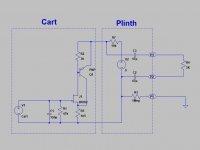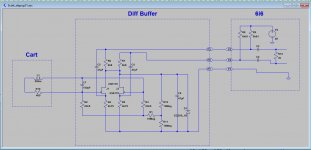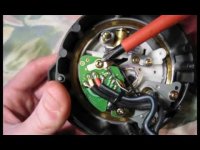If its getting digitised then does analog gain trim matter that much. The focusrite has individual gain pots on the analog inputs which could do that.
Right, the knobs on all these devices are hard to align channel to channel. For gain I assumed 2-3.5K input resistance on the mic pre-amps.
Last edited:
Agreed, but they need to be set at some point (or I take the lid of and hard wire them to a gain). I fear even max and min are not that tightly balanced.
A few minor remarks,This looks pretty good, -80dB at 50mV, gain of 8 to 10dB, only 6 small SMT parts and no film caps so it could ride on the headshell. Needs a trim or selection of R to match the two channels.
1)The BF862 can only have 20 V, So R3 must be ca 150k.
2) Why the dummy load on P2? It seems to serve no purpose.
3) When using a 9V battery, with 200uA per channel the battery would last for 750 hours, enough fot one year, and the Cart could be regarded as differential when connecting a 1Meg resistor between P1 and minus 9V.
See below.
Hans
Attachments
Yes trimming is necessary, and be aware that the 150pF input cap is also part of the trimming.If its getting digitised then does analog gain trim matter that much. The focusrite has individual gain pots on the analog inputs which could do that.
Hans
A few minor remarks,
1)The BF862 can only have 20 V, So R3 must be ca 150k.
2) Why the dummy load on P2? It seems to serve no purpose.
3) When using a 9V battery, with 200uA per channel the battery would last for 750 hours, enough fot one year, and the Cart could be regarded as differential when connecting a 1Meg resistor between P1 and minus 9V.
See below.
1) No the circuit as shown has ~9V on the drain of the FET that's how the resistor is selected.
2) Symmetry makes people feel good.
3) This is for 48 phantom power that is already available.
4) Why 1Meg why not 100Meg, pin 1 is essentially floating I suspect the mains incursion would be rather bad.
Last edited:
1) No the circuit as shown has ~9V on the drain of the FET that's how the resistor is selected.
4) Why 1Meg why not 100Meg, pin 1 is essentially floating I suspect the mains incursion would be rather bad.
200uA * (33k+6k8) = ca 8volt, leaving almost 40 Volt on the drain, right ?
And yes, 1Meg could also be 10Meg but it feels like a bit high to me.
Hans
200uA * (33k+6k8) = ca 8volt, leaving almost 40 Volt on the drain, right ?
No the resistor (~500 Ohms) is selected for 1mA of current from the phantom power. Hans you pick R1 to make the circuit draw 1mA and that makes the drain voltage ~9 or 10V there is no choice you have to accommodate any FET from the Idss range.
I(R4): 0.00104993 device_current
I(R3): 0.00104993 device_current
I(R1): 0.00104993 device_current
I(R12): 0 device_current
Last edited:
Hans, I was looking for a good combination of gain, noise, and THD. Using the phantom power the current draw is not important.
It might be useful with 9V to run lower but I doubt the kind of person fussing with this cares about changing a battery every 200hr. of use. More important is to take care in realizing that the effects of cable and grounding of the whole system need to be checked also. BTW floating the pin 1 does not make the signal differential.
Bill, doubling this up probably covers differential operation. Need to check bias, matching, etc.
It might be useful with 9V to run lower but I doubt the kind of person fussing with this cares about changing a battery every 200hr. of use. More important is to take care in realizing that the effects of cable and grounding of the whole system need to be checked also. BTW floating the pin 1 does not make the signal differential.
Bill, doubling this up probably covers differential operation. Need to check bias, matching, etc.
Last edited:
This mornings idea. The components for this look like they will fit on a .4 x .5 inch board (one channel on each side). So buy a spare set of headshell wires and cut .5" out and solder the ends to the board. Now you can use any cart and nothing to mod (need to fiddle with tracking force). Need to keep polarity straight this amp inverts.
Last edited:
You are right, but since I got 13dB gain with 1mA, I was playing with different resistor values, and that's where I measured almost 40Volt Drain voltage, so forget my comment.No the resistor (~500 Ohms) is selected for 1mA of current from the phantom power. Hans you pick R1 to make the circuit draw 1mA and that makes the drain voltage ~9 or 10V there is no choice you have to accommodate any FET from the Idss range.
It was a clever solution with the added BJT, but I think it is not something that will be used in practice.
It is quite a burden to attach a small PCB to the Cart and then to create a few new pins to connect the existing arm wires.
And it will make the whole thing quite inflexible, but anyhow it is possible.
The question is also, what benefit could be expected in terms of noise, FR or whatever against a solution built into the Plinth ?
This whole solution seems only be useful in case of using a digital soundprocessor.
And with a Soundprocessor there is phantom power.
Therefore the best option is to me is your differential design with this phantom power.
THD is ridiculously low, in the ppm range and noise is also very low.
The 2SK170 and the BF862 are both giving the same figures.
I have made a few minor changes and after extensive testing of all different versions and here it is in its full glory, being the best of them all, a MM head amp for a Soundprocessor.
Hans
Attachments
I think both are valid and I certainly want to breadboard them up. For some the idea of a headshell mounted preamp has felt like a holy grail for a while.
And until a few boards are sent out into the wild we don't know what will float boats. A lot of people would twitch at removing the earth connection from their MM much less running an extra wire to reconnect it!
Put a cooled load on that balanced board and would be very interesting if the power budget allows.
And until a few boards are sent out into the wild we don't know what will float boats. A lot of people would twitch at removing the earth connection from their MM much less running an extra wire to reconnect it!
Put a cooled load on that balanced board and would be very interesting if the power budget allows.
Last edited:
I think both are valid and I certainly want to breadboard them up. For some the idea of a headshell mounted preamp has felt like a holy grail for a while.
And until a few boards are sent out into the wild we don't know what will float boats. A lot of people would twitch at removing the earth connection from their MM much less running an extra wire to reconnect it!
In this specific case an SE version could be the better way to go.
What happens when you don't run an extra wire and leave the connection intact, do you happen to have any relevant experience ?
Although very well possible, would this make any sense?Put a cooled load on that balanced board and would be very interesting if the power budget allows.
SNR with the input short circuited as most Riaa preamps are specified is above an absurd 90dBA and resp. above 82dBA when including the 6i6.
With a Cart connected (580 mH +460 Ohm on 47K load) SNR is 81dBA after Riaa correction and 79dBA when including input noise from the 6i6.
With the same Cart and 7k27 termination, giving a pole at 75usec, SNR is 74dBA before and 73dBA after the 6i6 (Riaa correction with only 3180usec and 318usec)
This 73dBA, with Cart connected, is better than almost any commercial preamp, so that causes my question: Bill, does it make sense to add a cooling feature ?
Hans
A lot of people would twitch at removing the earth connection from their MM much less running an extra wire to reconnect it!
That was my reason for suggesting "active headshell wires" totally plug and play if you don't like it just put the wires back in. Hans is right if you use XLR the mirror image balancing is unnecessary but you do have to take care in where you ground pin2 or pin3.
Hans: I haven't tested the various options with MM yes. It's on my list to do when life allows me time. I also have some MM where you cannot get at the ground pin.
You make a compelling argument for not worrying about the noise hit for loading for the 75uS pole. It probably is more than good enough and certainly well worth testing as is to see if there is a problem.
You make a compelling argument for not worrying about the noise hit for loading for the 75uS pole. It probably is more than good enough and certainly well worth testing as is to see if there is a problem.
Doing some research on how this could be used and realised something. The most likely TT this will be used with will be classic technics because there are so many of them AND people who have a home studio are more likely to have them. These have no connectors between headshell and RCA, so whilst the brave can desolder things it does limit the audience. Whereas the single ended headshell version can be just fitted.
As both my tables use the 5 pin S-Din I hadn't clicked on that until I started talking to my guinea pig.
Not that the balanced solution is not still useful at the far end of the tonearm cable!
As both my tables use the 5 pin S-Din I hadn't clicked on that until I started talking to my guinea pig.
Not that the balanced solution is not still useful at the far end of the tonearm cable!
O.k Bill, understandable.Doing some research on how this could be used and realised something. The most likely TT this will be used with will be classic technics because there are so many of them AND people who have a home studio are more likely to have them. These have no connectors between headshell and RCA, so whilst the brave can desolder things it does limit the audience. Whereas the single ended headshell version can be just fitted.
As both my tables use the 5 pin S-Din I hadn't clicked on that until I started talking to my guinea pig.
Not that the balanced solution is not still useful at the far end of the tonearm cable!
Let me give you my testing results for the SE version.
Where the 2nd harmonic is cancelled by the Diff version, the SE does not.
But with Scotts CFP, THD reduces to ca. 0.01% at 50mV@20Khz.
Here are the two SE versions with added info inside.
One with phantom power and the other battery fed for use where no phantom power is available.
Hans
Attachments
You mis-understood me? I was talking about a tiny board inline with those 4 little wires. I my more stupid days I purchased a replacement set of silver Litz ones. No desoldering or grounding mods at all.
No I fully understood you, just using english in a clumsy way this morning.
Attached is SL-1200 wiring board for the tonearm. A drop in board with the balanced dodad on would be easy for anyone on this thread (and I want to try that), but might scare others off, so for technics users the no solder solution inline with headshell wires would be perfect.
Attachments
No I fully understood you, just using english in a clumsy way this morning.
Attached is SL-1200 wiring board for the tonearm. A drop in board with the balanced dodad on would be easy for anyone on this thread (and I want to try that), but might scare others off, so for technics users the no solder solution inline with headshell wires would be perfect.
I already realized that and it's true most users run away when any soldering is involved and in almost all cases it voids your warranty.
BTW the active headshell wire idea might actually have been patentable. It's better simply out in the public domain.
Enough people on ebay sell replacement wiring boards that there must be a core who would solder, but with 3million+ technics out there with that setup a lot more wont!
And of course you exchange units are possible as you can see whole arms and cables ready to drop in for sale on ebay. SL series have a healthy hotrod market so anything is possible! Time to face the wroth and get my SL-Q33 out of the shed.
And yes out in the open is good.
And of course you exchange units are possible as you can see whole arms and cables ready to drop in for sale on ebay. SL series have a healthy hotrod market so anything is possible! Time to face the wroth and get my SL-Q33 out of the shed.
And yes out in the open is good.
Scott,I already realized that and it's true most users run away when any soldering is involved and in almost all cases it voids your warranty.
BTW the active headshell wire idea might actually have been patentable. It's better simply out in the public domain.
What do you think would be the benefit of having the buffer attached on one end of the headshell wires, close to the Cart, over the alternative of having the buffer at the other end of these wires where they enter the plinth ?
Hans
- Home
- Source & Line
- Analogue Source
- Designing a universal diff-in/diff-out Head Amp



